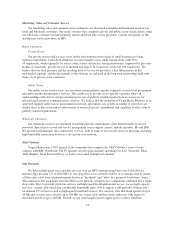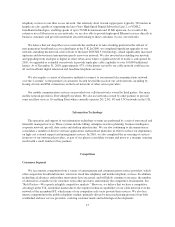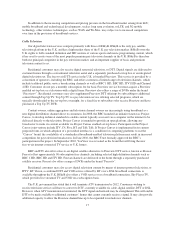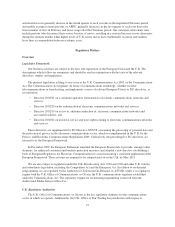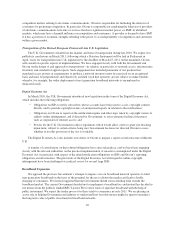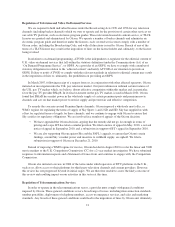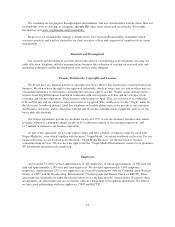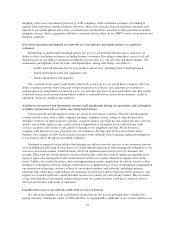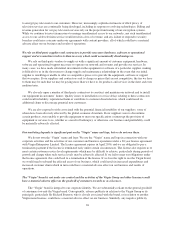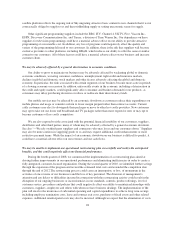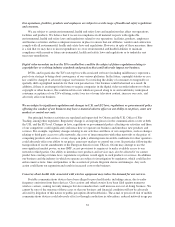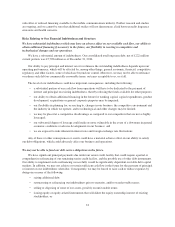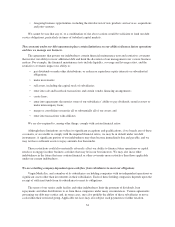Virgin Media 2010 Annual Report Download - page 27
Download and view the complete annual report
Please find page 27 of the 2010 Virgin Media annual report below. You can navigate through the pages in the report by either clicking on the pages listed below, or by using the keyword search tool below to find specific information within the annual report.ITEM 1A. RISK FACTORS
Our business, financial condition or results of operations could be materially adversely affected by any of
the risks and uncertainties described below. Additional risks not presently known to us, or that we currently deem
immaterial, may also impair our business.
Risks Relating to Our Business and Industry
We operate in highly competitive markets which may lead to a decrease in our ARPU, increased costs,
increased customer churn or a reduction in the rate of customer acquisition.
The markets for broadband internet, television, telephony and business services in which we operate are
highly competitive. We face significant competition from established and new competitors in each of these
markets, and believe that competition will intensify as technology evolves. For example, distribution of
entertainment and other information over the internet, as well as through mobile phones and other devices and
services such as the proposed YouView platform, continue to increase in popularity. These technological
developments are increasing the number of media choices available to subscribers. In addition, continued
consolidation within the media industry may permit more competitors to offer “triple-play” bundles of digital
television, fixed line telephone and broadband services, or “quad-play” bundles including mobile telephone
services. Consolidation by competitors even in some of our markets, such as the Everything Everywhere joint
venture between Orange and T-Mobile, can create economies of scale that we do not benefit from. Many of our
competitors are part of multi-national groups, and some may have substantially greater financial resources and
benefit from greater economies of scale than we do.
In order to compete effectively, we may be required to reduce the prices we charge for our services or
increase the value of our services without being able to recoup associated costs. In addition, some of our
competitors offer services that we are unable to offer. Any increase in competitive pressures in our markets may
lead to a decrease in our ARPU, increased costs, increased customer churn or a reduction in the rate of customer
acquisition, which could have an adverse effect on our business, financial condition, results of operations and
cash flows. See also “Business—Competition”.
The sectors in which we compete are subject to rapid and significant changes in technology, and the effect of
technological changes on our businesses cannot be predicted.
The broadband internet, television, telephony and business services sectors are characterized by rapid and
significant changes in technology. Advances in current technologies, such as VoIP (over fixed and mobile
technologies), 3D TV, mobile instant messaging (including both SMS and BBS), wireless fidelity, or WiFi, the
extension of local WiFi networks across greater distances, or WiMax, LTE, internet protocol television, or the
emergence of new technologies, may result in our core offerings becoming less competitive or render our
existing products and services obsolete. We may not be able to develop new products and services at the same
rate as our competitors (or at all) or keep up with trends in the technology market as well as our competitors (or
at all) which could lead to a decrease in our ARPU, increased costs, increased customer churn or a reduction in
the rate of customer acquisition, which could have an adverse effect on our business, financial condition, results
of operations and cash flows. See also “Business—Competition”.
The cost of implementing emerging and new technologies could be significant, and our ability to fund that
implementation may depend on our ability to obtain additional financing. Similarly, the deployment of new
technologies in the spectrum frequencies in which we operate could have a material adverse effect on the existing
services offered by us, with a consequential material adverse effect on our businesses.
Our fixed line telephony business is in decline and not likely to improve.
Demand for fixed line telephony is in decline, with the rate of decline in lines used by business nearly twice
as high as that in the residential fixed telephony market. There is a trend for businesses to replace fixed line
24


